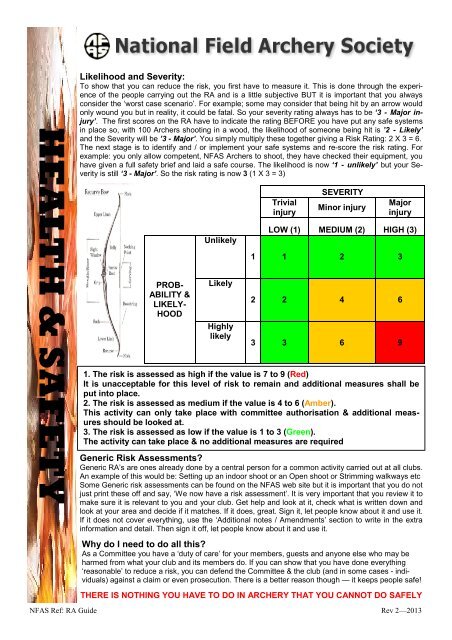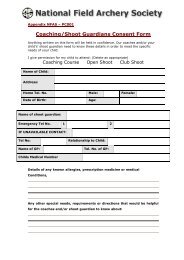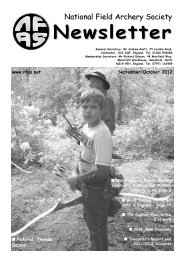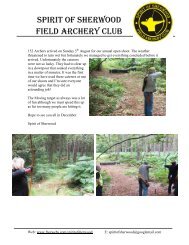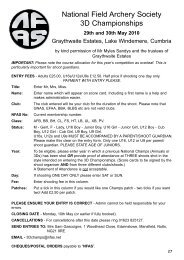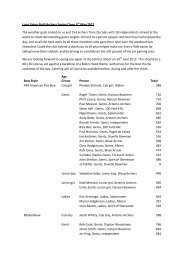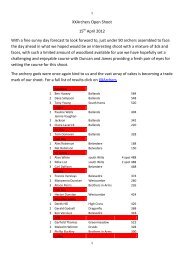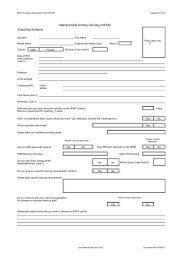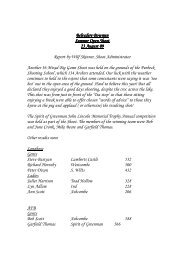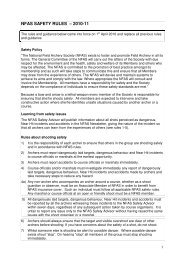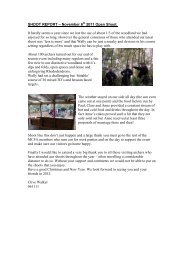Risk Assessment description.pub
Risk Assessment description.pub
Risk Assessment description.pub
You also want an ePaper? Increase the reach of your titles
YUMPU automatically turns print PDFs into web optimized ePapers that Google loves.
HEALTH & SAFETY<br />
Likelihood and Severity:<br />
To show that you can reduce the risk, you first have to measure it. This is done through the experience<br />
of the people carrying out the RA and is a little subjective BUT it is important that you always<br />
consider the ‘worst case scenario’. For example; some may consider that being hit by an arrow would<br />
only wound you but in reality, it could be fatal. So your severity rating always has to be ‘3 - Major injury’.<br />
The first scores on the RA have to indicate the rating BEFORE you have put any safe systems<br />
in place so, with 100 Archers shooting in a wood, the likelihood of someone being hit is ’2 - Likely’<br />
and the Severity will be ’3 - Major’. You simply multiply these together giving a <strong>Risk</strong> Rating: 2 X 3 = 6.<br />
The next stage is to identify and / or implement your safe systems and re-score the risk rating. For<br />
example: you only allow competent, NFAS Archers to shoot, they have checked their equipment, you<br />
have given a full safety brief and laid a safe course. The likelihood is now ‘1 - unlikely’ but your Severity<br />
is still ‘3 - Major’. So the risk rating is now 3 (1 X 3 = 3)<br />
PROB-<br />
ABILITY &<br />
LIKELY-<br />
HOOD<br />
Unlikely<br />
Likely<br />
Highly<br />
likely<br />
Trivial<br />
injury<br />
SEVERITY<br />
Minor injury<br />
Major<br />
injury<br />
LOW (1) MEDIUM (2) HIGH (3)<br />
1 1 2 3<br />
2 2 4 6<br />
3 3 6 9<br />
1. The risk is assessed as high if the value is 7 to 9 (Red)<br />
It is unacceptable for this level of risk to remain and additional measures shall be<br />
put into place.<br />
2. The risk is assessed as medium if the value is 4 to 6 (Amber).<br />
This activity can only take place with committee authorisation & additional measures<br />
should be looked at.<br />
3. The risk is assessed as low if the value is 1 to 3 (Green).<br />
The activity can take place & no additional measures are required<br />
Generic <strong>Risk</strong> <strong>Assessment</strong>s?<br />
Generic RA’s are ones already done by a central person for a common activity carried out at all clubs.<br />
An example of this would be: Setting up an indoor shoot or an Open shoot or Strimming walkways etc<br />
Some Generic risk assessments can be found on the NFAS web site but it is important that you do not<br />
just print these off and say, ‘We now have a risk assessment’. It is very important that you review it to<br />
make sure it is relevant to you and your club. Get help and look at it, check what is written down and<br />
look at your area and decide if it matches. If it does, great. Sign it, let people know about it and use it.<br />
If it does not cover everything, use the ‘Additional notes / Amendments’ section to write in the extra<br />
information and detail. Then sign it off, let people know about it and use it.<br />
Why do I need to do all this?<br />
As a Committee you have a ‘duty of care’ for your members, guests and anyone else who may be<br />
harmed from what your club and its members do. If you can show that you have done everything<br />
‘reasonable’ to reduce a risk, you can defend the Committee & the club (and in some cases - individuals)<br />
against a claim or even prosecution. There is a better reason though — it keeps people safe!<br />
THERE IS NOTHING YOU HAVE TO DO IN ARCHERY THAT YOU CANNOT DO SAFELY<br />
NFAS Ref: RA Guide Rev 2—2013
HEALTH & SAFETY<br />
Review:<br />
Reviews should be carried out on a ‘regular’ basis (at least annually),<br />
following significant changes to the process or people and following an<br />
accident or incident. Have there been any changes? Are there<br />
improvements you still need to make? Have your members spotted a<br />
problem? Have you learnt anything from accidents or near misses?<br />
Make sure your risk assessment stays up to date. Record the review<br />
Manual Handling:<br />
Committee<br />
Control<br />
The recommended safe working weights for manual handling at waist height<br />
are:-<br />
Up to 25 kg – one male<br />
Up to 20kg—One female<br />
Up to 48 kg – two males<br />
Up to 38kg—two female<br />
Up to 70 kg – three males<br />
Up to 60kg—three female<br />
Up to 95 kg – four males<br />
Up to 70kg—four female<br />
Over 95 kg – Should not be handled<br />
by manual means alone. Some form of mechanisation or<br />
mechanical assistance should also be used.<br />
The Manual Handling Operations Regs 1992 requires ‘suitable & sufficient’<br />
manual handling risk assessments for all manual handling tasks that could<br />
cause a significant risk. This is a separate & different RA to the one covered<br />
in pack. (For guidance refer to NFAS Safety Advisor and / or the HSE<br />
MAC tool by following this link: www.hse.gov.uk/msd/mac/introduction.htm )<br />
How the procedural safeguards are maintained<br />
The Committee will ensure that the members have been informed,<br />
and will check that instructions are being followed.<br />
Any incident must be reported to the Club Committee immediately.<br />
Procedures for Serious and Imminent Danger:<br />
In the event of a serious accident, please refer to your clubs Emergency<br />
Plan on how to respond. If a near miss incident occurs, the person who observed<br />
the act must report this to the Committee so that it can be investigated.<br />
Incident / Accident Reporting and Investigation:<br />
Summary:<br />
Who can help?<br />
All accidents / incidents shall be reported following the NFAS Reporting Procedure<br />
as laid out on the NFAS web site.<br />
Remember; a near miss is an accident waiting to happen.<br />
What could hurt you?<br />
How could it hurt you?<br />
How likely is it to hurt you?<br />
What is in place to stop it hurting you?<br />
What do you do if it does hurt you?<br />
Who else could be hurt?<br />
When all is in place and you feel safer, review it occasionally to check<br />
nothing has changed. If it has, update the risk assessment.<br />
Let people know<br />
The NFAS Safety Advisor<br />
Further information on <strong>Risk</strong> <strong>Assessment</strong>s is available on the HSE Website at:<br />
http://www.hse.gov.uk/risk/fivesteps.htm<br />
NFAS Ref: RA Guide Rev 2—2013
HEALTH & SAFETY<br />
<strong>Risk</strong> <strong>Assessment</strong> guide<br />
The Generic <strong>Risk</strong> <strong>Assessment</strong>s (RA’s) in the Club pack are intended to provide guidance on the key<br />
areas to examine in the preparation of RA’s by NFAS Members. These are not an exhaustive list nor<br />
should they be taken to cover all the individual circumstances relevant to any one Club. A risk assessment<br />
is simply a careful examination of what, in your Club / Shoot area, could cause harm to<br />
people, so that you can weigh up whether you have taken enough precautions or should do more to<br />
prevent harm. An area is available at the end of the RA for reviewing it to avoid re-writing for those<br />
not regularly doing RA’s. Members are reminded that RA’s are the starting point to improve safety in<br />
the Club and that the onus is on the Committee to ensure that their members have read and understand<br />
the relevant RA’s and that they have an on-going review policy.<br />
Terminology<br />
Hazard:<br />
<strong>Risk</strong>:<br />
Description:<br />
At <strong>Risk</strong>:<br />
Hazards:<br />
How harmed:<br />
<strong>Risk</strong> Control:<br />
Anything in the Club that can cause harm. Examples of hazards identified<br />
are Bows, arrows, the environment, vehicles, Manual Handling,<br />
falls from height, etc<br />
Is the chance that somebody could be harmed by these and other hazards,<br />
together with an indication of how serious the harm could be (i.e.<br />
An arrow: the risk could be a simple cut or a fatality. Manual handling:<br />
Lifting a boss could strain a back or be dropped on your foot causing<br />
bruising). The risk could be to people, equipment or property<br />
This should describe and / or name the activity or equipment<br />
This <strong>Risk</strong> <strong>Assessment</strong> will cover the activity stated and is required whether it<br />
runs just once or several times<br />
This should describe those most at risk of harm<br />
Such as the Club members, Archers or Public etc.<br />
This should provide an overview of the most significant hazards<br />
The significant hazards are: Equipment, people, the environment, Traffic<br />
management and Manual handling. Other hazards to consider are: Animals,<br />
Slips and Trips etc<br />
You should consider the potential harm to people or property<br />
Informing people of the risks such as lacerations or death<br />
This should describe how the risks are reduced<br />
Details of actions that should eliminate or reduce the risk of hazards to an<br />
acceptable level. The analysis of the likelihood and severity of the main<br />
hazards causing harm, taking into account existing and planned preventative<br />
and protective measures should be shown on the general risk assessment<br />
form. This should be available to those involved in the activity<br />
Record & implement: Putting the results of your risk assessment into practice will make a difference<br />
when looking after people and your Club. Writing down the results of your risk<br />
assessment and sharing them with your members, encourages you to do this. If, like<br />
many Clubs, you find that there are quite a lot of improvements that you could<br />
make, big and small, don’t try to do everything at once. Make a plan of action to<br />
deal with the most important things first. It makes sense to write it down so that you<br />
can show what you have done for insurance purposes and also keep your members<br />
informed. Implementation of the RA requires involvement of members. Training /<br />
familiarisation in the RA is required for it to be successful.<br />
NFAS Ref: RA Guide Rev 2—2013


